
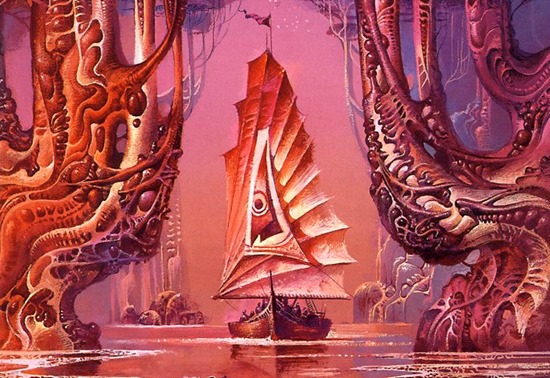 Mi ero occupato, tempo fa, della saga Riverworld di Philip José Farmer.
Mi ero occupato, tempo fa, della saga Riverworld di Philip José Farmer.
Pensavo di fare in fretta a dare tutte le indicazioni utili, per la ricerca dei vari romanzi, agli appassionati di SF che mi seguivano sulle ‘Lacrime’ di Uraniamania. Ma… accidenti: in cosa mai mi ero invischiato? Mi sono accorto, a mie spese, che la serie faceva confluire le lacrime, mie e di altri miei lettori, in un fiume senza fine.

Riverworld: la cronistoria
Il tutto iniziò con tre racconti, nei lontani anni 1965 e 1966 a causa di:
The Shasta Science-Fiction Prize Novel Contest.
In 1952 Phil decided to quit his job to become a full time writer and entered a contest sponsored by Shatsa Publishers and Pocket Books. After working day and night on the story he managed to get the manuscript for “Owe for the Flesh” in the mail on the last day. At first it seemed he made the proper decision as he won the contest and the $4000 prize, a lot of money for a writer in those days. Shasta did not pay him however and claimed that Pocket Books wanted some revisions and cuts before they would publish the paperback version of the book. Phil finally hired an agent who discovered that Pocket Books had paid their share of the prize money to Shasta long ago. Shasta had used the money to promote another book which was a flop. Shasta eventually filed for bankruptcy and never paid the prize money.
Phil had to stop writing full time and go back to work. If you look at the books and short stories list you can see that his production greatly dropped from 1954 to 1957. In the mid 60’s Frederick Pohl suggested that one book was too short for the riverworld idea and convinced Phil to write several novelette that he could publish in one of Pohl’s magazines.
1° – Day of the Great Shout: January 1965; Worlds of Tomorrow; Ed. Frederik Pohl; Galaxy Publishing Corp.; $ 0.50; pg.164.
Piazzato al 9° posto dell’Hugo 1966 come Best Short Fiction.
The first Riverworld novelette. This is basically the first half of what would eventually become TO YOUR SCATTERED BODIES GO.
La prima Novelette di Riverworld. Praticamente è la prima metà di quello che eventualmente sarebbe diventato il romanzo Il Fiume della Vita.
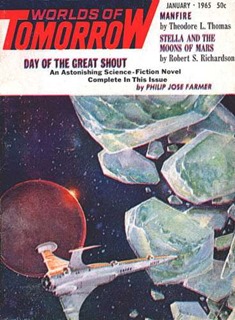
One morning the dead of Earth awoke with a great cry.
They were on the banks of a river of a planet somewhere in a star swarm. They were naked and in an interminable valley which offered no food—at first. The old had rejuvenated, so that an eighty-year-old, for instance, again had his twenty-five-year-old body. The diseased were healthy; the crippled walked straight; the misshapen were reshaped. Moreover, all men had awakened circumcised and were permanently without facial hair. All women were virgins again but forever sterile.
Worlds of Tomorrow: They were reborn on a fairer planet — to a new life, and a puzzle that shook the worlds!

2° – Riverworld: January 1966; Worlds of Tomorrow; Ed. Frederik Pohl; Galaxy Publishing Corp.; $ 0.50; pg. 164.
According to Farmer’s introduction to “Riverworld” in “Riverworld and Other Stories”, this story was “slightly expanded” for publication in “Down in the Black Gang and Others” in 1971. It was then expanded from 12,000 words to 33,750 words for publication in “Riverworld and Other Stories” in 1979. Judging by the page count, it was the last version that was published in Subterranean Press’ “The Best of Philip Jose Farmer” in 2006.
Tradotto in Italiano in SF Narrativa Anticipazione della Nord n. 24/racconto 1, Aprile 1981.
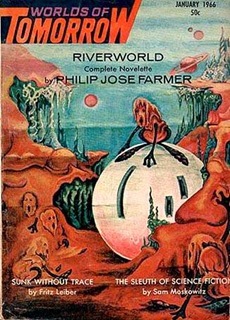

In questa storia Tom Mix è il personaggio principale. Ma sta viaggiando con un individuo misterioso che gli assomiglia.

3° – The Suicide Express: March 1966; Worlds of Tomorrow; Ed. Frederik Pohl; Galaxy Publishing Corp.; $ 0.50; pg. 164.
This is the second half of what would become TO YOUR SCATTERED BODIES GO.
Questa è, invece, la seconda metà di Il Fiume della Vita.
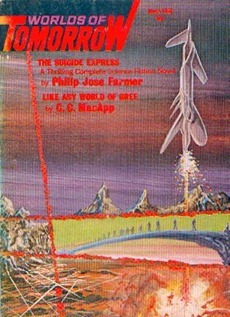

E il tutto sembrava essere finito lì. Ma il nostro amato scrittore che ti combina? Ricomincia ad ampliare il tutto (moda dell’epoca) e inserisce il primo e il terzo nel romanzo:
1 – To Your Scattered Bodies Go: January 1971; G. P. Putnam’s Sons; $ 4.95; pg. 223.
1° nel 1972 Hugo Best Novel
2° nel 1972 Locus Best SF Novel
Nomination 1972 Ditmar Best International Long Fiction
17° nel 1975 Locus All-Time Best Novel
27° nel 1987 Locus All-Time Best SF Novel
Tradotto in 15 lingue.
Il Fiume della Vita: Cosmo Argento n. 8 del Luglio 1971; Urania 1205 del 16 Maggio 1993

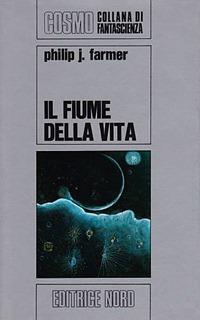
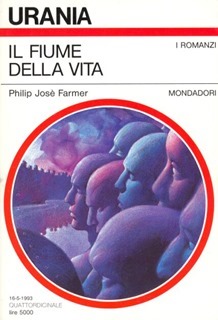
Una valle, un fiume. Entrambi, probabilmente, infiniti. E nella valle, sulla riva del fiume, tutta l’umanità di tutti i tempi, radunata. E’ come vedere che cosa accade « dopo » l’Apocalisse. Ma qui, sul fiume, non sembra che ci sia un Giudice. Gli uomini continuano a essere quel che erano prima. Personaggi dell’Ottocento, noti o anonimi, personaggi di secoli anteriori o successivi, tutti continuano ad agire con la propria mentalità e secondo se stessi. Nemmeno la morte può distruggerli, poiché subito rinascono. Ma l’uomo non può stare fermo. Ci sarà sempre l’esploratore che spinto dalla sua sete insaziabile di scoperta risalirà il fiume. Le incredibili ma fatali avventure che lo attendono, la sua personale partecipazione alle stesse, i suoi incontri e i suoi scontri con altre personalità, le straordinarie risorse che impiega, tutto ciò avvince il lettore con un ritmo incessante e incalzante. Che cosa c’è, sul fiume? Da dove comincia? Quali sono le sue sorgenti? Come si potrà risalire alla fonte, capire questa inspiegabile condizione di un’umanità risorta nella valle del Giudizio Universale – e scoprire quali sono i Giudici (o il Giudice) che la stanno ad osservare?

2 – The Fabulous Riverboat: apparso come Novel nel Novembre 1971; Putnam: $ 5.95; pg. 251.
Precedentemente come The Felled Star (Part 1 & 2) in:
If, July 1967; Ed. Frederik Pohl; Galaxy Publishing Corp; New York; $ 0.50; pg. 164
If, August 1967; Ed. Frederik Pohl; Galaxy Publishing Corp; New York; $ 0.60; pg. 164
e The Fabulous Riverboat (Part 1 & 2) in:
If, May-June 1971; Ed. Ejler Jakobsson; UPD Publishing Corporation; $ 0.75; pg. 180
If, July-August 1971; Ed. Ejler Jakobsson; UPD Publishing Corporation; $ 0.75; pg. 180
8a pos. nel Premio Locus del 1972 come Best SF Novel.
Alle Sorgenti del Fiume: Cosmo Argento n. 20 Agosto 1972; Urania n. 1222 del 9 Gennaio 1994
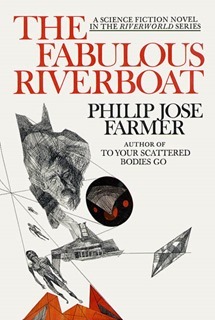

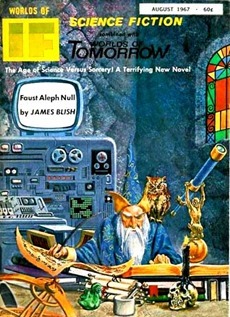
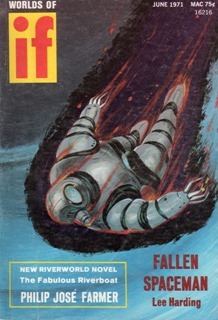

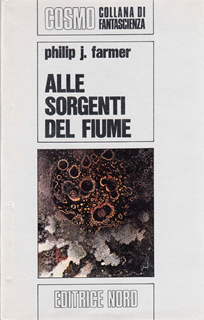
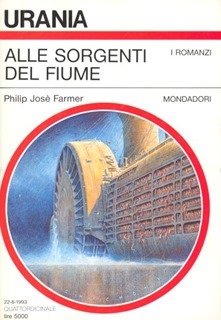
Un fiume lungo milioni di chilometri su un mondo sconosciuto: è questo il luogo dove l’intera razza umana risorge dopo la morte. Nel primo volume di questa famosissima serie, Il fiume della vita, L’esploratore inglese Sir Richard Burton aveva già tentato di trovare la chiave dell’enigmatico paradiso in cui miliardi di donne e uomini condividono un destino avvolto nel mistero. Ora, nel tentativo di scoprire la verità, lo scrittore americano Samuel Clemens – più noto come Mark Twain – getta le fondamenta di un vero e proprio regno e progetta di costruire un battello fluviale che, simile a quelli del Mississippi, risalga alle sorgenti dell’immenso fiume della vita.

3 – The Dark Design: Oct. 1977; Berkley/Putnam; ISBN 0-399-12031-9; $ 9.95; pg. 412.
14a pos. nel Premio Locus 1978 come Best SF Novel.
Il Grande Disegno: Cosmo Argento n. 77/78 del Luglio 1978; Grandi Opere Nord n. 21/1 dell’Ottobre 1992; Urania n. 1222 del 9 Gennaio 1994;
Nota: Il Grandi Opere n. 21 è stato presentato in due volumi: il 21/1 e 21/2.
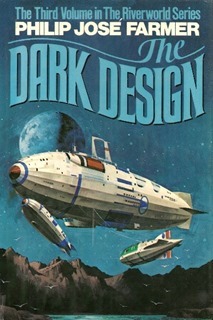
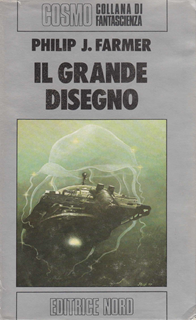
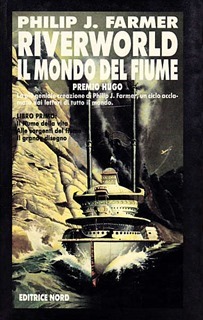
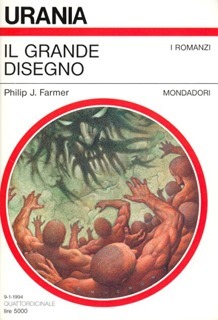
Avevamo lasciato gli eroi del Fiume – dai più semplici ai più famosi, da un resuscitato qualsiasi a spiriti illustri come l’esploratore Richard Burton e Mark Twain – lungo le rive di un fiume immenso, su un pianeta sconosciuto dove per motivi misteriosi tutta l’umanità risorge dopo la morte. Ora si tratta di scoprire qual è il disegno oscuro, il motivo insomma, che si nasconde dietro questa grandiosa macchinazione. Man mano che procede, questa saga dantesca si arricchisce di nuovi elementi e nuovi personaggi, costruendo davanti ai nostri occhi un mondo straordinario per varietà e ricchezza d’invenzione. Mescolando abilmente mito, letteratura fantastica, satira sul presente e il futuro, Il grande disegno resta uno dei capolavori più godibili della sf moderna.

4 – The Magic Labyrinth: May 1980; Phantasia Press; ISBN 0-932096-04-2; $ 30.00; pg.339
10a pos. nel Premio Locus 1981come Best SF Novel.
Il Labirinto Magico: Cosmo Argento n. 113-114 del Luglio 1981; Grandi Opere Nord n. 21/2 dell’Ottobre 199;. Urania n. 1230 del 1° Maggio 1994.

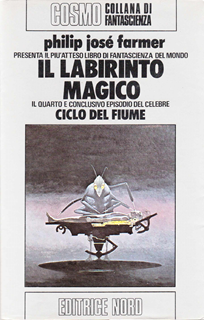
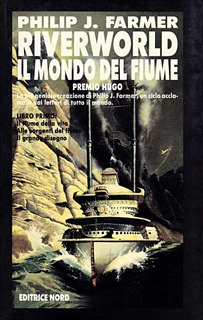
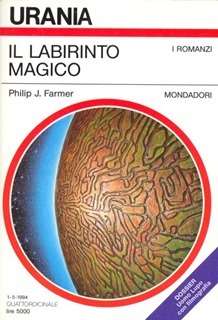
Siamo ormai nel cuore della grandiosa vicenda immaginata. Soli e allo sbaraglio su un immenso pianeta dove uomini e donne di tutte le epoche resuscitano dopo morte in riva a un grande fiume, i protagonisti (veri e propri miracolati loro malgrado) si rendono conto di essere le pedine di un gioco molto più grande di loro. Ma chi manovra le fila del progetto Resurrezione? E perché? Le domande, che si moltiplicano con l’incalzare dell’azione, troveranno tutte una risposta.
Si tratta infatti del quarto libro del Ciclo del Fiume della vita. Qui vengono svelati tutti i misteri del favoloso Mondo del Fiume, il fantastico pianeta artificiale percorso da un fiume lungo quindici milioni di chilometri, sulle cui rive sono stati fatti risorgere tutti gli esseri umani che hanno vissuto sulla Terra dai primordi fino alla fine del nostro secolo. Negli episodi abbiamo fatto la conoscenza di Richard Francis Burton, di Samuel Clemens, vale a dire Mark Twain, di Cyrano de Bergerac, Jack London, Tom Mix, Re Giovanni Senza Terra, e tantissimi altri personaggi. Qui li ritroveremo quasi tutti, ancora intenti nel difficile tentativo di raggiungere le sorgenti del Fiume e la Torre proibita che nasconde il segreto dell’origine del mondo e degli Etici, gli esseri alieni che hanno riportato in vita l’umanità per chissà quale strano esperimento; e ritroveremo anche X lo Straniero Misterioso, uno degli Etici, il traditore che, per motivi suoi e occulti, e contrariamente al volere dei suoi simili, aiuta Burton e Clemens nel loro viaggio verso la regione polare settentrionale, un viaggio lunghissimo, interminabile, pieno di insidie e di pericoli verso la meta più ambita: la verità assoluta sull’esistenza umana.

5 – Gods of Riverworld: Aug 1983; Phantasia Press; ISBN 0-932096-24-7; $ 50.00; pg. 279
16a pos. nel Premio Locus del 1984 come Best SF Novel.
Gli Dei del Fiume: Cosmo Argento n. 162 del Dicembre 1985; Grandi Opere Nord n. 21/2 dell’Ottobre 1992; ; Urania n. 1248 del Gennaio 1995.
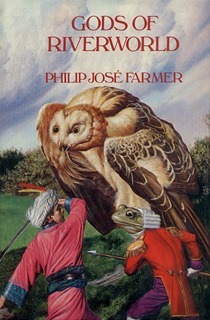
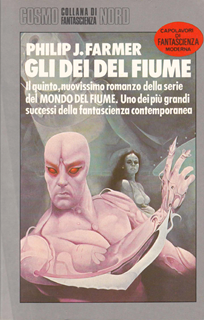


L’appassionante avventura dei Resuscitati lungo il Fiume della Vita si avvia a conclusione: scopriremo così i segreti di un pianeta dove i morti possono risorgere e di una razza evolutissima che gioca con l’umanità una partita metafisica.
Più di venti anni fa Philip José Farmer iniziò la meravigliosa saga del Mondo del Fiume, un pianeta percorso da un fiume infinito e sulle cui rive è radunata tutta l’umanità di tutti i tempi: trentacinque miliardi di uomini e donne che si sono svegliati una mattina per ricominciare una nuova vita dopo la morte. Resuscitati dall’incredibile potere tecnologico di una razza aliena, per motivi che neanche lontanamente riescono a immaginare, personaggi di tutte le epoche come Mark Twain (alias Samuel Clemens), Hermann Göring, Cyrano de Bergerac, Giovanni Senza Terra, Tom Mix, Richard Francis Burton, vagano sulle sponde di questo incredibile fiume alla ricerca dei padroni di questo mondo e delle risposte ai suoi misteri. Alcune delle loro domande hanno ricevuto una risposta, dopo la scoperta della gigantesca torre che si leva nei pressi della calotta polare artica. Qui si trova il grande computer che controlla il processo della resurrezione, e la padronanza di questo meccanismo potrebbe farli diventare “dei” del Fiume. Ma altri problemi e altre domande sorgono, perché scoprono di non essere soli nella torre. Strani passi si sentono nei corridoi, misteriosi incidenti avvengono, e alcuni di loro riescono solo fortunosamente a sfuggire alla morte: tutto sembra condurre a una inevitabile conclusione: o c’è un assassino rimasto nella torre oppure uno del loro gruppo vuole diventare il dio incontrastato del Mondo del Fiume.

Bene, direte voi, in Italia è stato pubblicato tutto.
Magari, rispondo io!
Nel 1980 viene pubblicato:
Riverworld War: The Suppressed Fiction of Philip José Farmer; Jun 1980; The Ellis Press; ISBN 0-933180-13-6; $ 6.95; pg 107.
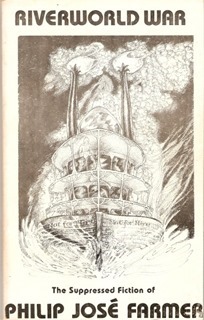
Che contiene una prefazione, una novella ed una novelette:
1 – Jesus on Mars: novella.
Notes: Jesus on Mars is a highly condensed version of the novel, scheduled to appear in Isaac Asmov’s Science Fiction Magazine. Due to miscommunication the novel appeared first, and the story publication had to be cancelled.
Cristo Marziano – Classici Urania n. 175, Ottobre 1991.
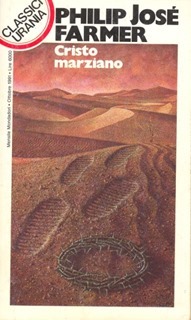
In un domani più o meno lontano l’uomo emigrerà nello spazio abbandonando il pianeta che gli ha dato la vita, il mondo su cui è nato e dove sono nate la sua arte, la sua filosofia e ancor prima le sue religioni. Ma è mai possibile lasciarsi dietro un bagaglio di questo genere? Probabilmente no, e nello spazio continueranno a vivere vecchie illusioni e speranze. Debitamente aggiornate, è ovvio: Gesu Cristo sbarca sul pianeta Marte e apre l’era del Vangelo interplanetario.
![]()
2 – Riverworld War: Novelette.
Che consiste di 5 capitoli esclusi dal romanzo “The Magic Labyrinth”.
mai tradotti.

Poi nel 1983 appare “River of Eternity”: stampate solamente 3.000 copie, delle quali 500 firmate dall’autore.
Qualche copia si trova ancora in commercio. Il prezzo si aggira attorno ai 60 Euro per una copia usata (150 per una autografata) e dai 150 ai 250 euro per la nuova, naturalmente solamente in inglese (non eccessivamente caro, vero?)
River of Eternity: Nov 1983; Phantasia Press; ISBN 0-932096-28-X; $ 40.00; pg. 205.
The book includes a ten page “Author’s Introduction,” wherein Farmer relates the history of the Riverworld series. After the introduction is a page that states “This novel is complete in itself, but is part of a larger project, a paramyth tentatively titled I Owe for the Flesh, composed of four books: The Great Cry, A State of Honesty, The River of Eternity, and The Paddle Wheeled Comet. Any resemblance to anybody is not coincidental, for this book is populated with all of humanity and some that are not human.”
River of Eternity is an early version of what became the Riverworld series by Philip José Farmer.
The original “Riverworld” story was a 150,000-word novel titled Owe for the Flesh, which ended with the protagonist (called Richard Black in this version) finding the tower at the end of the river. In the mid-1950s, Farmer entered it in a science fiction novel contest run by Shasta Publishers and subsidized by Pocket Books. He won the contest but received no money. The work was never published and was lost in its original form. Farmer revised and retitled the book River of Eternity, but that version remained unpublished as well and was thought lost. In the 1960s, Farmer reworked the material yet again into the magazine novellas and serials that would form the final Riverworld sequence. Then in 1983, a copy of the River of Eternity manuscript was discovered in a garage and published by Phantasia Press. Farmer recounts the whole story in his introduction to the Phantasia edition of River of Eternity.
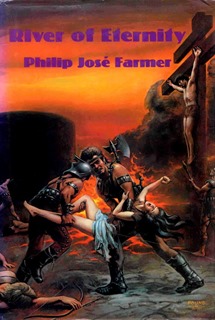

E come se non bastasse ci si mettono pure altri scrittori a raccontare storie del Fiume.
Nel 1992 esce Tales of Riverworld: Aug. 1992; Warner Books; ISBN 0-446-36269-7; Pg. 326; $4.99
6a pos. nel Premio Locus 1993 come Best Anthology
con i seguenti racconti:
1 – Crossing the Dark River, novella di Philip José Farmer
2 – A Hole in Hell, di Philip José Farmer [as by Dane Helstrom].
3 – Graceland, di Allen Steele.
4 – Every Man a God, di Mike Resnick and Barry N. Malzberg.
5 – Blandings on Riverworld, di Phillip C. Jennings.
6 – Two Thieves, di Harry Turtledove.
7 – Fool’s Paradise, di Ed Gorman.
8 – The Merry Men of Riverworld, di John Gregory Betancourt
9 – Unfinished Business, di Robert Weinberg.

A Hole in Hell (protagonista Dante Alighieri) è stato tradotto (credo amatorialmente) per la versione ebook di una antologia intitolata “I racconti di Riverworld” che raccoglie i seguenti titoli:
– Riverworld (Riverworld, 1966)
– Attraversando il fiume oscuro** (Crossing the Dark River, 1992). –
– Su per il fiume luminoso** (Up the Bright River, 1993)
– Coda** (Coda, 1993). Pure in Gli avventurieri di Riverworld
– Un buco all’Inferno (A Hole in Hell, 1993)
Laddove non arriva l’editoria arrivano gli appassionati.
** Pure in:
Gli avventurieri di Riverworld – Cosmo Argento n. 247 del Marzo 1994.
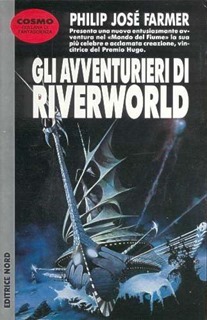
Riverworld, il Mondo del Fiume, un pianeta percorso da un fiume infinito, sulle cui rive è radunata tutta l’umanità di tutti i tempi: trentacinque miliardi di uomini e donne che si sono svegliati all’improvviso per ricominciare una nuova vita dopo la morte. Resuscitati da un incredibile potere tecnologico per motivi che neanche lontanamente riescono a immaginare, personaggi di tutte le epoche, vagano sulle sponde di questo incredibile fiume, uniti da un solo obiettivo: raggiungere le sue sorgenti ma, soprattutto, scoprire il segreto dell’origine del mondo e dei misteriosi esseri che hanno riportato in vita l’umanità per chissà quale strano esperimento. Ma i misteri non sono finiti, e sulle rive del Fiume altri straordinari personaggi inseguono la verità: il Dottor Faustroll, genio della patafisca, ovvero la scienza delle soluzioni immaginarie, il medico Andrew Paxton Davis, il re vichingo Ivar il Senzaossa e altri ancora.

Ed infine nel 1993 si presenta sul mercato
Quest to Riverworld:
una Antologia coi seguenti racconti:
1 – Up the Bright River, novelette by Philip José Farmer – vedi Gli Avventurieri di Riverworld.
2 – If the King Like Not the Comedy, novelette by Jody Lynn Nye.
3 – Because It’s There, novelette by Jerry Oltion.
4 – A Place of Miracles, shortstory by Owl Goingback.
5 – Diaghilev Plays Riverworld, novelette by Robert Sheckley.
6 – Secret Crimes, novelette by Robert Sampson.
7 – Hero’s Coin, shortstory by Brad Strickland.
8 – Human Spirit, Beetle Spirit, novelette by John Gregory Betancourt.
9 – Nevermore, novelette by David Bischoff and Dean Wesley Smith.
10 – Old Soldiers, shortstory by Lawrence Watt-Evans.
11 – Legends, novelette by Esther M. Friesner.
12 – Stephen Comes into Courage, novelette by Rick Wilber.
13 – Riverworld Roulette, novelette by Robert Weinberg.
14 – Coda, shortstory by Philip José Farmer – vedi Gli Avventurieri di Riverworld.
Pure questi mai tradotti eccetto il primo e l’ultimo.

Particolare curioso: mentre Tales of Riverworld mi è arrivato abbastanza presto dagli Stati Uniti (dove l’avevo ordinato), l’altro: Quest to Riverworld, ha impiegato oltre due mesi per giungere a destinazione. La colpa di chi era? Ma naturalmente dei vogatori che in Quest hanno vogato dall’altra parte e hanno fatto il giro del mondo.

E naturalmente non potevano mancare le serie televisive.

Riverworld TV Series Pilot
2003
A movie for the Sci Fi Channel, starring Brad Johnson, Karen Holness, Emily Lloyd, Jeremy Birchall, Kevin Smith, Nikita Kearsley and Brian Moore, based on the book series by Philip José Farmer. In this unique and daring fantasy adventure we travel to RIVERWORLD, a mysterious and treacherous land where every human who died between the years 99,000 BC and 2,200 AD has been resurrected on the banks of a colossal river. It is on the riverbank where we follow a team who bond together as they try to unravel how and why they’ve arrived here, while coming face-to-face with some of the most dangerous people in history.
Riverworld Miniseries
2010


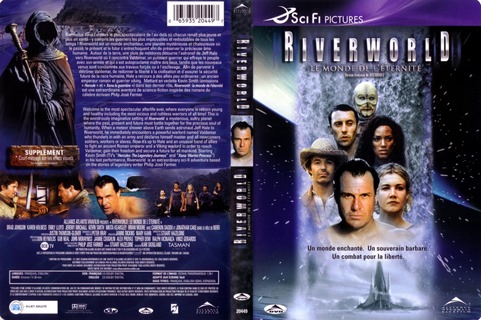
On April 18th, 2010 the Syfy channel aired a four hour miniseries event starring Tahmoh Penikett, Peter Wingfield, Laura Vandervoort, Mark Deklin, Jeananne Goossen, and Alan Cumming. This miniseries is a complete reboot and has nothing to do with the pilot aired in 2003. It is rumored to be a “backdoor” pilot meaning that if ratings are strong enough, it could become a series. Other than a report that it was their highest rated Sunday program in 2010, and some positive chatter on their forums there is no word yet if there is interest in continuing the series.
A short review containing spoilers
Ok, having lived through the first Riverworld TV adaptation, we didn’t have very high expectations. We knew they were going to do things like have staggered resurrections. So the protagonist wakes up on a new world and discovers people who have been there for years and who know how everything works. Thus we lose one of the most fun parts of TO YOUR SCATTERED BODIES GO, the “Day of the Great Shout” where everyone who ever lived on earth suddenly wakes up naked, hairless, in a 25 year old version of their body, lying on a crowded riverbank. This of course causes many of them to completely freak out as this is not the afterlife they expected. For some reason both versions had horses even though there are no animals in the books other than fish and insects. Both versions had to make the protagonist a modern American instead of an interesting historical character like Sir Richard Francis Burton. Both versions did have Mark Twain, because most Americans have heard of him.
One thing the second version did do, was have Burton as a character, yea! But as a villian instead of the protagonist, boo! This was an interesting twist. During the novels Burton, and others, are being fed information and given help by a race of “Ethicals,” to reach the tower at the end of the River. But we never really understand the motivation of their mysterious helpers. The miniseries turns this around and shows us characters being helped by “Caretakers” to stop Burton. We still don’t know why rival Caretakers are trying to help or hinder Burton’s quest, but now our focus is on the opposite side of the battle. Then the payoff at the end is that we finally see things from Burton’s point of view. Now we’re supposed to be conflicted and not know if Burton was right in his quest or not. Was our modern American hero wrong all along in trying to stop Burton (his only real movitation being that Burton stole his girl, who of course has been on the River for years before he woke up)?
As noted above, this was an interesting approach. It might have worked nicely except for one thing; in making Burton “look” like the villian, they made him a villian. It isn’t a case of just misunderstanding his motivation when he’s constantly giving orders like, “Burn her at the stake” and “Kill them all.” No, this Burton is an asshole that no one would route for at all if he wasn’t being played by Peter Wingfield (by the way, we love Peter Wingfield, but they might as well have cast Mos Def if they weren’t even going to try and find someone who looked anything at all like Burton).
Having said all that, we’re still hoping for a TV series. Maybe with some practice the writers will figure out how to best utilize this amazing world Farmer created.
Come vedete in italiano qualcosa manca sempre.
Ferdinando Temporin
